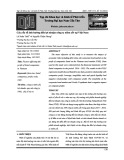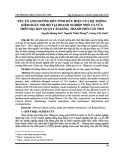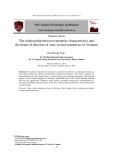
VNU Journal of Economics and Business, Vol. 4, No. 6 (2024) 21-31
21
Original Article
Expense management for green transition
in businesses for sustainability:
Factors affecting electric vehicles depreciation management
in transportation enterprises in Vietnam
Nguyen Thi Thuy Dung*
University of Transport and Communications
No. 3, Cau Giay Street, Lang Thuong Ward, Dong Da District, Hanoi, Vietnam
Received: October 30, 2024
Revised: December 11, 2024; Accepted: December 25, 2024
Abstract: The study’s goal is to analyse the factors influencing the effectiveness of expense
management, particular devaluation expense, for means of transport in transportation enterprises as
they transition to greener modes of transport, notably electric modes of transport; in other words, to
investigate the Effectiveness of Depreciation Management for Electric Vehicles (EDMEV). The
study conducted a survey of 36 transportation enterprises in Vietnam and discovered that 23/36
planned to transition to green modes of transportation, specifically electric vehicles. However, the
process of establishing financial planning, particularly involving depreciation cost accounting and
management for fixed assets, continues to present both objective and subjective challenges. In-depth
interviews with ten experts (including accounting staff, managers, and planning department staff)
were conducted to determine the main factors that have a substantial impact on EDMEV. From
there, the study used the previous interview content to conduct additional interviews with 110
accounting staff, managers, and planning department staff from businesses operating in this field.
The research used the EFA method to identify some factors influencing the EDMEV, as well as
regression analysis to assess the level of influence of these factors on EDMEV in related financial
projects. The study tested 7 groups of factors (Legal, Human, Software, System, Characteristic, Age,
Size) and found out 2 groups of factors that had less statistically significant impact: Software and
Age. From there, the study proposed a number of groups of solutions for businesses in the industry.
Keywords: Depreciation expense, electric vehicles, transportation enterprises.
1. Introduction*
The transportation sector plays a critical role
in global sustainability efforts, and electric
________
* Corresponding author
E-mail address: dungntt89@utc.edu.vn
https://doi.org/10.57110/vnu-jeb.v4i6.350
Copyright © 2024 The author(s)
Licensing: This article is published under a CC BY-NC
4.0 license.
vehicles (EVs) have emerged as a pivotal
technology in the industry’s green transition.
When converting to green transportation,
transportation businesses need financial plans to
: This article is published under a CC BY-NC 4.0 license.
VNU Journal of Economics and Business
Journal homepage: https://jeb.ueb.edu.vn

N.T.T. Dung / VNU Journal of Economics and Business, Vol. 4, No. 6 (2024) 21-31
22
ensure that the transition will be profitable.
However, in making revenue and cost plans,
performing accounting for costs related to fixed
assets that are EVs according to actual
exploitation is a very difficult problem (Braekers
et al., 2016). Managing EV assets brings unique
challenges, particularly in terms of depreciation,
given the high initial costs and distinctive
operational demands of EVs, including battery life
and charging infrastructure. Accurate depreciation
management for EVs is essential for transportation
enterprises, as it directly affects financial planning,
asset valuation, and cost recovery strategies,
impacting profitability and investment decisions.
Due to the lack of complete data and research
on depreciation management of EVs, researchers
investigating the costs of EVs often assume the
same depreciation rates for EVs as for
conventional vehicles (Hagman et al., 2016).
Contrast this with (Lévay et al., 2017), where the
depreciation rate of EVs was supposed to be
different from conventional vehicles due to
technical characteristics. Therefore, businesses
must research the implementation of depreciation
accounting for their EVs to come up with
reasonable financial plans, ensuring compliance
with the actual exploitation situation.
This study aims to address these challenges
by identifying and analyzing the factors that
influence EV depreciation management within
transportation companies, with a specific focus
on Vietnamese enterprises. Vietnam represents
an ideal case due to its emerging transportation
sector, which is increasingly adopting EV
technology amid rising government support and
environmental awareness. Unlike in high-income
countries with well-established EV infrastructure,
Vietnam faces infrastructural and regulatory
challenges unique to developing markets, offering
a valuable case study on depreciation management
under less predictable conditions.
We employ a mixed-methods approach,
including in-depth interviews, exploratory factor
analysis (EFA), and regression modeling, to
investigate the factors affecting EV depreciation
in the transportation industry. By examining
these dynamics, we contribute to the literature on
sustainable transportation and asset
management, providing insights relevant to
emerging and established markets alike.
2. Literature review and hypothesis
development
2.1. Managing the depreciation of EVs in the
transition is complicated
Multiple researches have demonstrated that
the devaluation of EVs is more complicated
compared to that of normal petrol vehicles. In
their study, Gilmore and Lave (2013) were
pioneers in examining the expenses and decline
in value of vehicles equipped with various power
systems. It was discovered that vehicles with
improved fuel efficiency exhibit distinct patterns of
depreciation and require more complicated
management.
Dexheimer (2003) examined the
determination of appropriate depreciation values
for EVs using data from over 24,000 publicly
available used vehicle in US, Norway, and
Germany. The calculation findings indicate that
effective management of electric vehicle
depreciation requires careful consideration of
aspects such as age, mileage, and purchase cost
in order to develop a rational management
approach. Guo and Zhou (2019) conducted an
analysis of EVs in the US from 2010 to 2016. Both
parties reached the same conclusion that EVs
experience a higher rate of depreciation compared
to gasoline vehicles.
When gasoline vehicles are used, the
management of their value and duration aspects of
depreciation differs from that of new EVs.
Consequently, the information required for
managing used EVs will also differ from new ones
(Wróblewski & Lewicki, 2021).
Battery depreciation is a major cost factor for
EVs and significantly impacts the overall
lifespan and depreciation of the vehicle.
Nevertheless, the battery's duration is not
constant; it can be increased by 4% to 50% by
properly managing battery degradation during
the charging process (Hoke et al., 2011).
Applying various charging techniques can
effectively prolong the lifespan and enhance the
durability of the battery, hence influencing the
rate of depreciation. In their study, Felipe et al.
(2014) demonstrated that implementing a partial
recharge strategy can result in substantial cost
savings. Specifically, they found that using
partial charging led to average cost savings
ranging from 1.2% to 1.7% compared to the

N.T.T. Dung / VNU Journal of Economics and Business, Vol. 4, No. 6 (2024) 21-31
23
empty charging strategy (Dallinger, 2013) . In
order to mitigate the expense associated with
battery degradation in EVs, In their EVRP model
address the issue of battery depreciation cost,
which is resolved using the differential evolution
algorithm (Barco et al., 2017).
Many researches have tried to develop some
models to manage the depreciation expense
better. Goke and Liao (Goeke & Schneider,
2015; Liao et al., 2019) propose that managers
should take into account the depreciation cost
while modelling the Electric Vehicle Routing
Problem with Time Windows (EVRPTW)
model. This involves batteries or vehicles per
kilometre. The researchers utilise A Large
Neighbourhood Search (ALNS) and a hybrid
genetic algorithm to analyse their models
(Pelletier et al., 2016).
Intangible wear and tear focuses on
depreciation due to better technologies on the
market . From an environmental perspective,
many studies show that older cars have poorer
performance and more outdated technology,
which is associated with a higher environmental
burden and increased risk of lawsuits (Lukić et
al., 2016). This creates more pressure on the
green transition.
2.2. Factors affecting depreciation management
Many studies examine the current
accounting-related legal document system and
offer comprehensive guidance to improve
depreciation management. The law has
undergone thorough study and provides a crucial
foundation for organisations to apply as a guide.
For instance, regulations governing the overall
depreciation schedule and the appropriate
depreciation techniques for certain car models
(Ovsiychuk & Demin, 2010).
H1: Well-defined legal regulations on
depreciation accounting (LGL) positively affect
the effectiveness of depreciation management for
EVs (EDMEV).
According to some researches, human
resources are especially significant. Managerial
reports are separate from accounting reports in
an organisation because they are created for
management purposes. Managers are interested in
the actual depreciation of vehicles, which can be
modified flexibly (Zhu, 2020) .
H2: Qualified human resources (HMN)
positively affects the effectiveness of depreciation
management for EVs (EDMEV)
Accounting software systems, asset
management software, tracking software and
others will help staff members by providing
accounting data for asset and depreciation
management. Software is a potent instrument
that can help perform depreciation expense
management in an efficient manner (Soysal et
al., 2012).
H3: The efficient software system (SFW)
positively affects the effectiveness of depreciation
management for EVs (EDMEV).
The effectiveness of depreciation
management is also significantly impacted by
the means of the transportation system; factors
such as the quantity, kind, and brand of vehicles
as well as shared and linked vehicle systems all
have an impact on the depreciation management
of the vehicle system (Donati et al., 2008).
H4: The well organized EV system (SYS)
positively affect the effectiveness of depreciation
management for EVs (EDMEV).
Depreciation management will be less
complicated if the vehicle is operated at a stable
battery level, operates at a low frequency, or has
a stable charging station system. When the
vehicle is driven at a high frequency, the battery
level fluctuates, and there isn’t a charging station
nearby, the irregularities will get harsher and make
management more difficult (Save et al., 2019).
H5: Stable characteristics (CHA) positively
affects the effectiveness of depreciation
management for EVs (EDMEV).
Besides that, Enterprise age and Size are
frequently cited variables in financial
management literature. Older enterprises are
generally more experienced with capital-
intensive asset management and may have
developed more sophisticated financial
strategies and depreciation policies, enabling
them to adapt more effectively to the unique
characteristics of green vehicle depreciation.
Larger enterprises often have access to advanced
technology, financing options, and skilled
professionals, which facilitate more precise and
strategic depreciation management for green
vehicles. This makes it likely that larger enterprises
can better manage the unique depreciation risks
associated with green vehicles.

N.T.T. Dung / VNU Journal of Economics and Business, Vol. 4, No. 6 (2024) 21-31
24
H6: Enterprise age (AGE) positively affects
the effectiveness of depreciation management for
EVs (EDMEV).
H7: Enterprise size (SIZ) positively affects the
effectiveness of depreciation management for EVs
(EDMEV).
The research overview reveals that the
transition from gasoline-powered automobiles to
EVs necessitates greater consideration in business
management accounting. It relates to the 3 main
aspects: time management, value management and
related vehicles’ components management.
The management of depreciation in practice
will be effective if changes related to
depreciation are statistically recorded,
continuously updated and depreciation values
are recorded in the books close to the actual price
reduction (Nechaev et al., 2017) . Thus, updating
value changes, management of detailed value
changes and accurately determining value
changes will be three aspects of the effectiveness
of vehicle depreciation management over time.
Numerous studies have been conducted in
Vietnam on the factors influencing the
application of managerial accounting for
expenses in businesses (Yen, 2024). Various
cost types in a wide range of industries,
including the building, manufacturing , and
food were mentioned. However, because EV
projects are still relatively new in the
Vietnamese market, no comprehensive study has
been conducted to analyse depreciation
management for EVs.
For transportation companies in Vietnam, in
the process of transition to EVs, if they can
manage vehicle depreciation costs well, it will
ensure the construction of reasonable exploitation
and make suitable plans related to repair,
maintenance, and upgrades for vehicles as well as
plans for liquidation and replacement of vehicles.
This emphasises the need for further
research into how electric vehicle depreciation is
managed in practical scenarios, particularly into
the factors influencing companies' operations
during a certain time frame.
3. Research methods and data
General description and the process of research
The study conducted 2 surveys to determine
the factors affecting EDMEV. The number of
enterprises intending to transition to green
transportation in Vietnam remains limited.
Based on data from the Ministry of Transport,
the research team was able to identify only 36
companies with public commitments to green
and sustainable development and initial actions
toward a green transition. Of these, only 23
companies have concrete plans and have
conducted thorough research on the transition
process, indicating a stronger commitment to
adopting green transportation practices.
Data were gathered through structured surveys
and interviews with key personnel in finance and
operations through direct phone calls and face to
face interviews to capture a comprehensive view of
depreciation management practices.
We employed exploratory factor analysis
(EFA) to identify and validate underlying
constructs, followed by regression analysis to
assess the impact of each factor. The EFA
results, verified by Cronbach’s Alpha and KMO
testing, confirmed the reliability of our variables.
After the EFA test, and 2 more control
variables, AGE - Age of the enterprise (taking
value = 1 if > = 10 years, otherwise = 0) and SIZ
- Enterprise size (takes value = 1 if it is a large
enterprise, otherwise = 0).
The research process (see Figure 1).
The survey number one:
Purpose: Develop a questionnaire with
criteria to evaluate EDMEV activities and
identify factors affecting EDMEV.
Respondents: 10 accounting staff, managers,
and planning department staff who are
responsible.
Survey format: In-depth interviews, group.
Survey results 01 show that there are 5 main
groups of factors (including 12 small factors) for
the independent variable.
Based on the literature review and the
survey’s result, depreciation management for
electric vehicle projects identified 5 major
categories of aspects (with 12 subgroups). On
the dependent variable side, the group discussion
decided to use 2/3 of the content for the
dependent variable: “Planned frequency of
recording changes to DEV” and “Planned
tracking fluctuations of EV details”. The content
“Accuracy of Planned DEV and actual DEV” is
not suitable for the research sample because
most businesses have plans but have not
implemented them yet.

N.T.T. Dung / VNU Journal of Economics and Business, Vol. 4, No. 6 (2024) 21-31
25
Figure 1: Research process
Source: Designed by the author.
Table 1: Current situation EDMEV and difficulties for EDMEV
Legal regulations on depreciation accounting for green transport vehicles.
Lack of technical regulations with in-depth parameters when depreciation for EVs, only depreciation for general
vehicles.
Depreciation can only be changed once per vehicle, which is inconsistent with the dynamic and uncertain
changes of assets.
Financial accounting personnel capacity.
Experience in providing exploitation and depreciation plans related to EVs has only been conducted in a very
small number (5 projects in a total sample of 36 enterprises).
Actual depreciation accounting has a large gap with vehicle depreciation in implemented projects,
demonstrating the low judgment ability of financial and technical accounting personnel.
Software system.
Most mode updates are done manually, and errors easily occur.
Vehicle depreciation is allocated according to regulations installed on most software, with little customization
according to actual needs.
The electric vehicle system plans to operate.
The larger the number of vehicles in a project, the more difficult it is to manage.
The more expensive the electric vehicle, the more difficult it is to manage depreciation.
Most still lack flexible links with outside parties, especially in exploiting operations and battery charging.
Electric vehicle specification.
The current exploitation frequency is very high, affecting complex depreciation work.
The level of depreciation of the battery and the vehicle depends largely on how the vehicle is operated with the
battery. Whether the vehicle is maintained at a stable threshold or not will affect the reasonable determination
of the vehicle's depreciation value.
Charging stations are not convenient, making it difficult to evaluate the impact of charging on depreciation to
determine depreciation.
The effectiveness of depreciation management for EVs.
Most businesses only manage depreciation costs once a year, a few have a management plan every 6 months
and only 1 enterprise has a quarterly management plan.
Most businesses do not manage to separate EV components to manage depreciation, especially the vehicle’s
battery. A small number of companies plan to purchase asset management and tracking software abroad to track
details of components such as chassis, engine, battery, and electrical system of the vehicle.
Source: Author’s survey.
STEP 1
Research overview
Evaluation criteria and factors
affecting EDMEV
STEP 2
In-depth survey for questionnaire for EDMEV evaluation
criteria and EDMEV influencing factors
Questionnaire
STEP 3
STEP 4
STEP 5
Variables from EFA combine 2 control
variables, run linear regression
Linear regression results
Survey to collect data according to
questionnaire
Survey data according to
questionnaire
Process data from STEP 3, run EFA
EFA results


![Cẩm nang Quản trị công ty [chuẩn nhất]](https://cdn.tailieu.vn/images/document/thumbnail/2025/20251017/kimphuong1001/135x160/18931760671537.jpg)
![Tài liệu học tập Quản trị kinh doanh quốc tế [mới nhất/chuẩn nhất]](https://cdn.tailieu.vn/images/document/thumbnail/2025/20250722/vijiraiya/135x160/2551753169877.jpg)






















